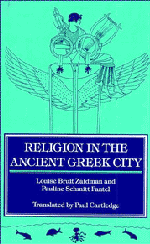Book contents
- Frontmatter
- Contents
- List of illustrations
- Author's preface to the English translation
- Translator's introduction
- List of sources
- PART I Introduction: How should we study Greek civic religion?
- PART II Cult-practices
- 4 Rituals
- 5 Religious personnel
- 6 Places of cult
- 7 Rites of passage
- 8 Settings of religious life
- 9 Religion and political life
- 10 The festival system: the Athenian case
- 11 The Panhellenic cults
- PART III Systems for representing the divine
- PART IV Envoi
- Appendixes
- Bibliography
- Index
8 - Settings of religious life
Published online by Cambridge University Press: 05 June 2012
- Frontmatter
- Contents
- List of illustrations
- Author's preface to the English translation
- Translator's introduction
- List of sources
- PART I Introduction: How should we study Greek civic religion?
- PART II Cult-practices
- 4 Rituals
- 5 Religious personnel
- 6 Places of cult
- 7 Rites of passage
- 8 Settings of religious life
- 9 Religion and political life
- 10 The festival system: the Athenian case
- 11 The Panhellenic cults
- PART III Systems for representing the divine
- PART IV Envoi
- Appendixes
- Bibliography
- Index
Summary
THE HOUSEHOLD (OIKOS)
‘Household’ is a more appropriate rendering of the Greek oikos than ‘family’, since the latter is, for us, synonymous with the restricted group of parents and children. The Greek oikos was something quite different, both in size and in nature. It was a complex entity embracing both people and property, bound together by common ties of kinship, residence and labour. Thus it could embrace also the unrelated persons and the slaves who lived and worked within the same unit.
The oikos had no legal status as such but it did possess a distinct religious identity through its performance of cults focussed on the home. Zeus Herkeios (‘Guardian of the Fence or Enclosure’) had his altar for sacrifice in the courtyard. Since Zeus protected the home, he also, as Zeus Xenios, oversaw the observance within it of the rules of xenia (hospitality, ritualized friendship). The Greek world was fundamentally governed by the institution of hospitality, which not only linked individual households within a city but provided a framework for relations between cities. The task of Zeus in yet another of his manifestations, Ktesios, was to safeguard property (ktēmata).
Inside the house a fire was kept constantly burning in the hearth, the seat of the goddess Hestia. It was around the hearth that the members of the oikos partook of the meal through which they registered their common identity; here too were enacted the rituals for the admission of newcomers (a baby, a wife, or a slave: chapter 7).
- Type
- Chapter
- Information
- Religion in the Ancient Greek City , pp. 80 - 91Publisher: Cambridge University PressPrint publication year: 1992

